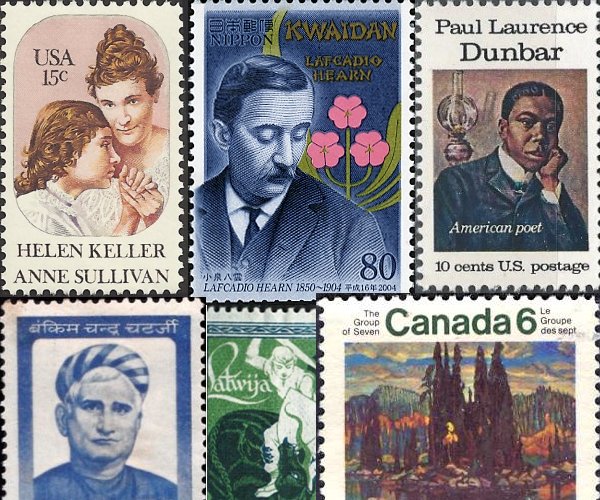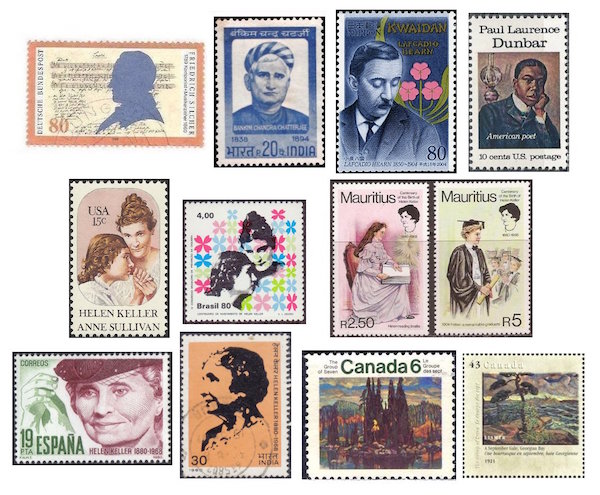The Arts on Stamps of the World — June 27
An Arts Fuse regular feature: the arts on stamps of the world.

By Doug Briscoe
Born on June 27 were Lafcadio Hearn, Paul Laurence Dunbar, Helen Keller, and other creative artists from Bengal, Canada, Latvia, and Austria; and we wind up with a couple of big names from the current movie blockbuster scene.
First in chronology comes German composer Friedrich Silcher (27 June 1789 – 26 August 1860). He was an important folk song collector who, as a composer, devoted himself almost exclusively to songs in folk style. He decided to become a composer after meeting Weber and went on to study with Conradin Kreutzer and Hummel. I remember an old LP of songs he wrote based, not on folk melodies, but on themes derived from Beethoven’s symphonies and sonatas. His bicentenary was marked with the issue of this stamp.
The Bengali writer Bankim Chandra Chattopadhyay (or Chatterjee; 27 June 1838 – 8 April 1894) is yet another example of the journalist-turned-versifier-turned-novelist, but I don’t at all mean to imply that he was run-of-the-mill. Indeed, some see him as the finest of Bengali novelists. His first published fiction, Rajmohan’s Wife, is probably the first novel in English written by an Indian. This was followed by the first novel ever written in Bengali, Durgeshnondini (1865). Chattopadhyay’s 1882 novel Anandamath (The Abbey of Bliss) contains verse that was set to music by Rabindranath Tagore and eventually became the National Song of India.
Another “Eastern” writer was the fascinating Lafcadio Hearn (1850 – 26 September 1904), the son of an Irish father and Greek mother. His unusual name is derived from the island where he was born, Lefkada. Taken to Ireland, Hearn was abandoned in sequence, first by his father, then his mother (who had the excuse of mental illness), then by his great-aunt, though she at least waited until he was seventeen. Bankrupted, she sent him off to London, and a distant cousin, who later cheated Hearn of his inheritance, shipped him off to New York, leaving him to his own devices. But those devices included a quick brain and a gift for writing. In Cincinnati he got work in a printing house and as a reporter and story writer. His first marriage, which didn’t last long, was to an African-American woman in 1874. Around the time of their divorce he moved to New Orleans, where he remained for ten years. Despite his poor eyesight, worsened by a childhood accident that left him blind in one eye, Hearn created woodcuts (here’s an example) for the Daily City Item. He translated works by Guy de Maupassant, Anatole France, and Pierre Loti into English, while at the same time writing copiously about his adopted city, its denizens, and its multifaceted culture. He spent two years in Martinique as a correspondent, and after that found what was in a sense his true home, Japan, where he spent the last fourteen years of his life, writing and teaching. He remarried, making him surely almost unique as a 19th-century Caucasian man who was married to both an African-American and a Japanese! Four tales from one of his Japanese books, Kwaidan: Stories and Studies of Strange Things (1903), were adapted into a 1964 film by Masaki Kobayashi.

Today’s third consecutive writer is the African-American Paul Laurence Dunbar (June 27, 1872 – February 9, 1906). Another early achiever, he was president of his high school’s literary society and had his first poems published in a Dayton newspaper by the age of 16. He subsidized the printing of his first poetry collection and made back his investment, but more importantly, caught the attention of James Whitcomb Riley, who like Dunbar, wrote popular poems in dialect. (Most of the poems in Dunbar’s book, however, were in traditional poetic language.) This recognition led to support from other quarters, including a positive review from William Dean Howells, followed by national and then international repute. In addition to a dozen volumes of poetry, Dunbar produced four short story collections, a single play, and four novels, one of which, The Uncalled (1898), is one of the first novels by a black author about white characters. Dunbar also provided the lyrics for In Dahomey (1903), the first Broadway musical written, composed, and performed entirely by African-Americans. His productivity was cut short by tuberculosis, of which he died at age 33. Samuel Coleridge-Taylor, whom Dunbar met while visiting Britain in 1897, set some of the poet’s words to music, and many years later, another composer, William Grant Still, used lines from Dunbar as epigraphs to the movements of his Afro-American Symphony (1930). The title of Maya Angelou’s autobiographical volume I Know Why the Caged Bird Sings is drawn from a line in Dunbar’s poem “Sympathy”.
As a writer, Helen Keller (June 27, 1880 – June 1, 1968) produced a dozen books, and The Story of My Life (1903), written when she was only 22, served as the basis for William Gibson’s play The Miracle Worker. The late Patty Duke famously played Helen in the 1962 film and Helen’s teacher Anne Sullivan in a 1979 remake. The pair are seen together on the US and Brazilian centenary stamps (1980). Keller, who was born in Alabama and attended Watertown’s Perkins School for the Blind, worked tirelessly not only for the handicapped, but also for women’s suffrage, labor rights, and other causes. Other countries that have honored Keller on stamps are Mauritius, Spain, and India. Keller also appears on the reverse of the 2003 Alabama state quarter, the only US coin to feature a phrase in braille.
Time for another of Canada’s Group of Seven, whose members we’ve been presenting here on The Arts on Stamps of the World as their birthdays come up. Arthur Lismer (27 June 1885 – 23 March 1969) was one of the original members along with Frank Johnston, whose work we just sampled here last week. Lismer was English-born and went to Antwerp when he was twenty and to Canada six years later (1911). He served as an official artist during World War I, concentrating on ships, particularly those camouflaged with “dazzle” painting—the idea behind that was to disorient potential attackers by making it difficult for observers to fix a ship’s range, speed, and heading. An example is seen in Lismer’s Olympic with Returned Soldiers (1919). The stamps, though, show two of Lismer’s landscapes: Isles of Spruce (1922) and A September Gale, Georgia Bay (1921). Arthur Lismer also served as the first artistic director of Toronto’s Hart House Theatre.

Two stamp designers share this June 27 birthday. The earlier of them, by nearly a century, is Latvian graphic artist Rihards Zariņš (1869 – April 21, 1939). He studied in St. Petersburg, Berlin, Munich, Vienna, and Paris. Returning to Russia, he worked with the Russian Imperial Printing Office for 20 years designing state papers and such. He went back to Latvia in 1919, just after the country achieved independence, and became director of the new government’s printing house. Toward the end of his life he suffered a stroke and lost the power of speech but was able to continue drawing. Zariņš made many book illustrations, engravings, and lithographs in addition to his stamp designs for Latvia and Russia. In fact he was responsible for the very first Soviet stamps (1918). These I show in the collage along with two early Latvian examples. Zariņš also created the designs for the Latvian coat of arms and various Latvian bank notes and coins.
A living counterpart of Zariņš is the Austrian painter and lithographer Adolf “Adi” Tuma (born June 27, 1956). Besides his paintings and work in decorative architecture, Tuma has designed stamps for Austria (we see a pair celebrating Austrian-Chinese relations with pictures of musical instruments respresentative of those countries), Liechtenstein (White Storks in the Alpine River Valley, 2003), and Luxembourg.
On the pop entertainment front, it’s sci-fi and superheroes (triple exclamation mark)—happy birthday to Star Wars: The Force Awakens director J.J. Abrams (born June 27, 1966 and served with a couple of Force Awakens stamps from Congo) and Spiderman embodier Tobey Maguire (born June 27, 1975 and shown in Spiderman deshabille on an issue from Benin).
A graduate of the University of Massachusetts with a B.A. in English, Doug Briscoe worked in Boston classical music radio, at WCRB, WGBH, and WBUR, for about 25 years, beginning in 1977. He has the curious distinction of having succeeded Robert J. Lurtsema twice, first as host of WGBH’s weekday morning classical music program in 1993, then as host of the weekend program when Robert J.’s health failed in 2000. Doug also wrote liner notes for several of the late Gunther Schuller’s GM Recordings releases as well as program notes for the Boston Classical Orchestra. For the past few years he’s been posting a Facebook “blog” of classical music on stamps of the world, which has now been expanded to encompass all the arts for The Arts Fuse.
